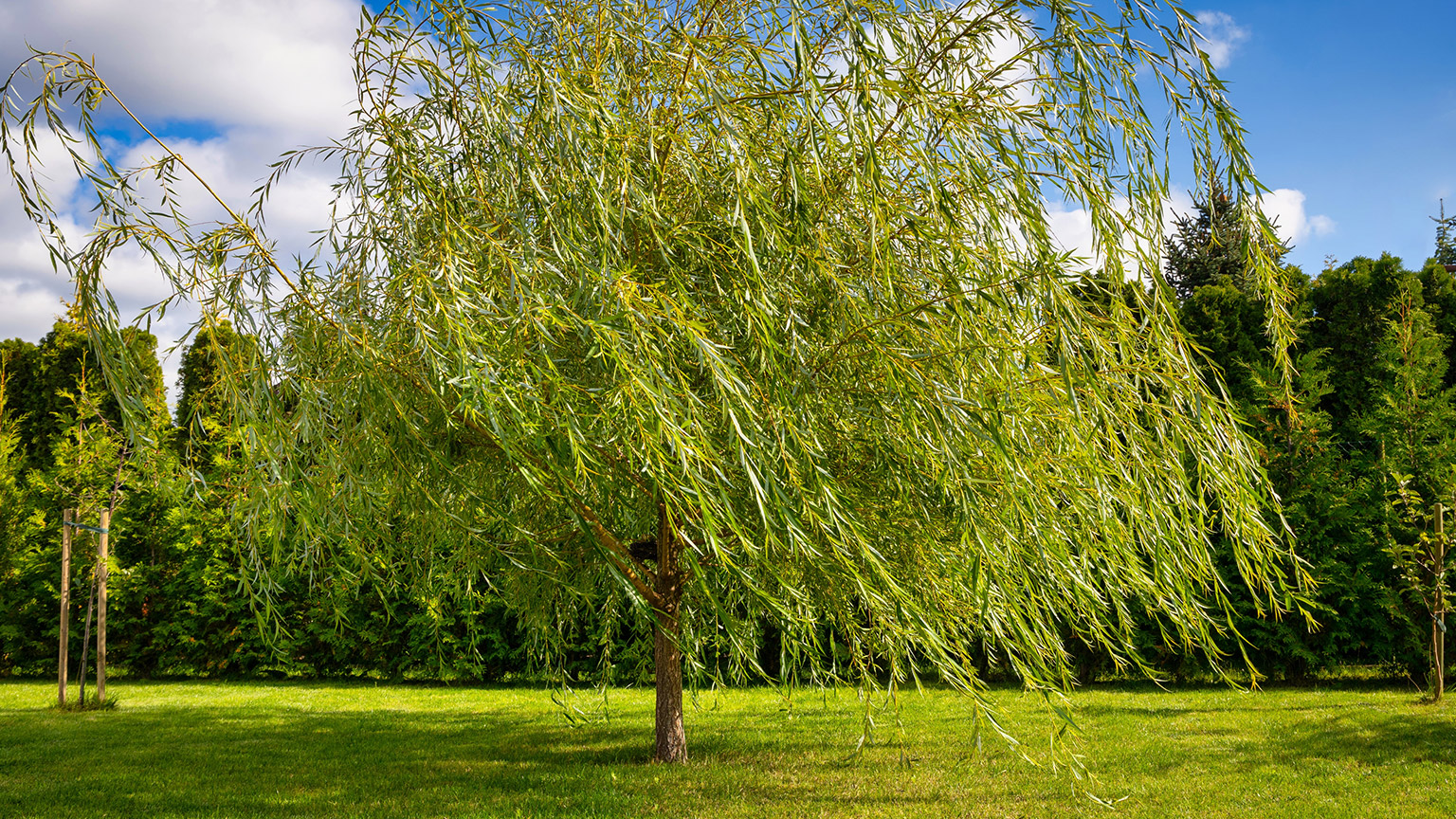Weeping willows (Salix babylonica) have a very large spread, which is one of the features used in identifying this tree.
Now we know how to classify plants and how to write their names correctly. Next, we'll look at how to correctly identify plants so we can be sure we're buying or propagating the right species.
When we talk about identifying characteristics, we are talking about the features of a plant that differ from one species to the next, and that can be described using agreed terms.
The main identifying characteristics are:
- plant form – its size and overall shape the plant forms in its natural environment
- leaves – for instance their type, shape, edge, arrangement, and colour
- flowers – such as their type, arrangement, and colour
- fruit – their shape, size, colour and markings, and texture
- trunk or stem – shape and or buttress, bark: its texture, colour, and markings.
Identifying characteristics of plant form
Being able to describe the size and overall shape of a plant is a good place to start. Doing so means you can narrow down your list by eliminating a whole lot of other plants that may have the same leaves but are a different plant form.
As mentioned earlier in the course, generally we use the term tree for a plant that is large and if it's smaller, we call it a shrub. But a more complete definition is that trees are typically taller than shrubs, with a single main trunk that grows upwards to form a canopy. Shrubs, on the other hand, usually have multiple stems and branches that grow outwards to form a rounded shape.

Plant height and spread
If we're looking at a tree or shrub and we want to know what species it is, we can't assume that it has reached full size. In other words, if it's 10m tall, we can't say for certain it's not a young tōtara (Podocarpus totara var. totara) – these are much taller when mature. But we can be certain it's not a Podocarpus nivalis (alpine tōtara or mountain tōtara) which only grows up to 1.2m tall.
The same argument can be made for a plant's spread. Spread is the term used to describe how wide a plants canopy gets.
Plant form
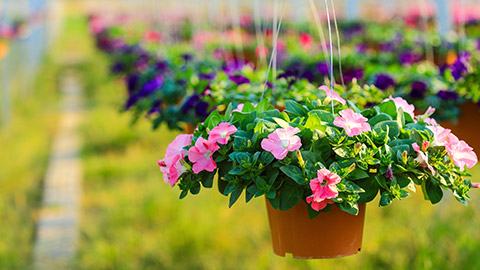
In the caption above, we use the term "spp.". Can you remember what that means? See if you know before expanding the label or selecting the (+) sign to see if you are right.
The answer: spp. means several species and is not italicised when written, such as Petunia (Petunia spp.)
A plant's form (also known as habit or growth habit) refers to the overall shape or silhouette it creates when growing in its natural environment without intervention. Common plant forms/growth habits include:
- Columnar: These trees have a narrow, upright growth habit and tend to be tall and narrow, with branches that are closely spaced together. An example of a columnar trees is the Italian cypress (Cupressus sempervirens).
- Conical/pyramidal: These trees have a triangular shape, with a single central leader and branches that gradually get shorter as they go up the trunk. Most pine trees have a conical form.
- Weeping: These trees have drooping branches that give them a "weeping" appearance. Examples of weeping trees include the weeping willow (Salix babylonica), weeping cherry (Prunus pendula) and silver birch (Betula pendula).
- Rounded: These trees have a rounded or oval shape, with a broad crown and branches that extend outward from the trunk. Examples of rounded trees include oak trees (Quercus spp.) and most varieties of maple trees (Acer spp.).
- Spreading: These trees have a wide, spreading growth habit and tend to be shorter and wider than other tree forms. Examples of spreading trees include some varieties of magnolia (Magnolia spp.).
- Vase-shaped: These trees have a broad, spreading canopy with an open center, giving them a vase-like appearance. Examples of vase-shaped trees include crabapples, like the Adirondack crabapple (Malus 'Adirondack').
- Multi-stemmed: These trees have multiple trunks or stems that grow from the same root system, giving them a bushy appearance. An example of a multi-stemmed tree is the pohutakawa (Metrosideros excelsa).
- Upright (sometimes called erect): These annuals have a vertical growth habit, with a single central stem and branches that extend outward from the main trunk. Rudbeckia (Rudbeckia spp.) is an example of upright annuals.
- Creeping: These annuals have a trailing or creeping growth habit, with long stems that spread out over the ground or trail from hanging baskets. An example of trailing annuals are petunias (Petunia spp.).
- Mounded (sometimes called mound-forming or clump-forming): These annuals have a mounded or rounded growth habit, with branches that extend out in all directions from the center of the plant. Begonias (Begonia rex) are an example of mound-forming annuals.
- Creeping: These groundcovers have stems that spread out horizontally over the ground and take root at nodes along the stem. Creeping thyme (Thymus serpyllum) is an example of a creeping groundcover.
- Mat-forming: These groundcovers grow in dense mats that cover the ground and help to suppress weeds. Moss is a good example of a mat-forming groundcover.
- Clumping (sometimes called clump-forming): These groundcovers form clumps of foliage that spread slowly over time. Examples of clumping groundcovers include hostas (Hosta spp.) and the bush lily (Clivia miniata).
Climbers or vines are generally said to have a climbing habit. An example is kiwifruit (Actinidia deliciosa).
Identifying characteristics of leaves
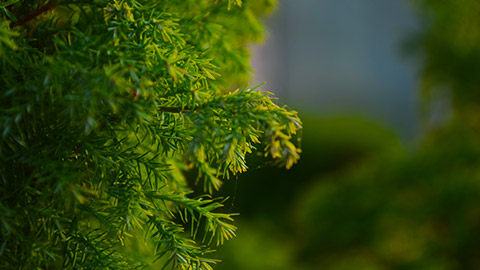
Leaves are one of the most important features when it comes to plant identification. In part, this is because they remain on the tree for longer than the flowers or fruit, but also because they have so many different aspects that can be described.
Leaf type and arrangement
Leaf type refers to the leaf's overall shape and structure, whereas the leaf arrangement refers to how these leaves are attached to and ordered on a stem. We've combined these two features here for simplicity. Some of the most common leaf types and arrangements are:
- Simple leaves: have a single blade that is not divided into smaller leaflets. The leaves of New Zealand flax (Phormium tenax) are long and sword-shaped, with a single blade that is not divided into smaller leaflets.
- Compound leaves: consist of several smaller leaflets attached to a single leaf stalk (petiole). The leaves of kowhai trees (Sophora species) are pinnately compound, consisting of several small leaflets attached to a single leaf stalk.
- Doubly compound leaves: consist of several leaflets that are arranged in pairs, and each pair is attached to a larger leaf stalk. The leaves of the karaka tree (Corynocarpus laevigatus) are doubly compound, consisting of several pairs of leaflets attached to a larger leaf stalk.
- Whorled leaves: three or more leaves that emerge from the same node or point on a stem like the kahikatea (Dacrycarpus dacrydioides).
- Opposite leaves: two leaves that emerge from the same node on a stem, like kāpuka (Griselinia littoralis) are opposite, with two leaves emerging from the same node on a stem.
- Alternate leaves: one leaf emerges from each node on a stem, like the leaves of the kanuka tree (Kunzea ericoides).
There are others too. Some digital tools, like the NZ Trees app, give both the name and a picture to help make it easier to use.
Leaf shape
Several of the most common leaf shapes are:
- Lanceolate: long and narrow, widest at the base and tapering towards the tip, like the leaves of willow trees.
- Oblong: like lanceolate, but with a more even width throughout the leaf, like the leaves of many fruit trees.
- Elliptical: oval-shaped, with a length greater than the width, like the leaves of magnolia trees.
- Ovate: egg-shaped, with a rounded tip and a tapered base, like the leaves of most deciduous trees.
- Cordate: heart-shaped, with a rounded base and a pointed tip, like the leaves of some species of maple trees.
- Palmate: hand-shaped, with several lobes radiating from a central point, like the leaves of a maple tree.
- Pinnate: feather-shaped, with leaflets arranged on either side of a central axis, like the leaves of an ash tree.
- Reniform: kidney-shaped, with a rounded base and a pointed tip, like the leaves of some species of clover.
Leaf size
Leaf size is commonly indicated in centimetres (or occasionally millimetres) and written as the length and then the width. The measurements are usually written as a range. For instance "5-10 x 4-5cm" means a leaf that it is generally between 5 and 10cm long and between 4 and 5cm wide at the widest part.
Leaf margin
The leaf margin (also called the leaf edge) description explains the smoothness, or otherwise, of the leaf. These include:
- Entire: smooth and uninterrupted edges, like the leaves of magnolia trees.
- Toothed: serrated or jagged edges, like the leaves of many oak trees.
- Lobed: edges with deep indentations, like the leaves of maple trees.
- Doubly serrate: a type of toothed edge where the teeth themselves have smaller teeth, like the leaves of birch trees.
- Sinuate: wavy or undulating edges, like the leaves of some types of oak trees.
- Spiny: edges with sharp, pointed thorns or spines, like the leaves of holly bushes.
- Crenate: scalloped edges, like the leaves of many species of hydrangea.
- Fringed: edges with small, hair-like projections, like the leaves of some ferns.
Activity – Sketching leaves
Task 1: Learn how to identify leaves by using your own hands to sketch them. Look up each of the leaf shapes and margins online and draw them on a sketchpad or in a notebook.
Task 2: When you are out and about, notice the leaf shapes and margins around you and identify them to yourself.
Leaf colour and texture
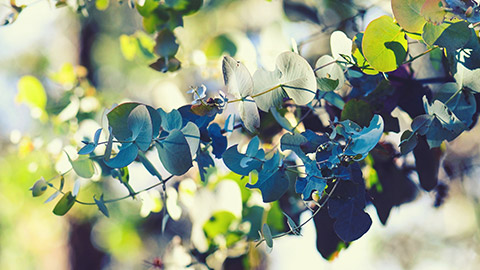
Leaf colour, also referred to as foliage colour, is fairly straightforward, particularly for evergreen plants. However, some variation can still occur, so descriptions can range from basic to complex, for example:
- silver-green
- dark green
- bright green
- young leaves are glossy light green with a fuzzy silver underside, maturing to glossy dark green with a mid-green underside
- dark red in spring, dark green in summer, bright red in autumn.
The terms glabrous and pubescent may sometime be used, where glabrous means smooth or hairless and pubescent means hairy.
Activity – Learning to describe and identify plants based on the leaf characteristics
When we combine all the leaf characteristics together, we get a detailed description of the leaves of the plant, which we can use to help identify the plant.
For instance, we may write:
Glossy, light green, simple, oval leaves, with smooth edges, in an alternate arrangement, approx. 7x5cm in size.
Task: Using pen and paper or your phone or computer, describe all the leaf characteristics for the following trees and shrubs:
Identifying characteristics of flowers
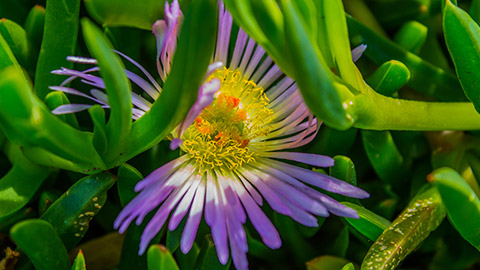
When present on the plant, flowers can be a useful feature to help us identify the plant.
Flower colour
One of the simplest descriptions is the colour of the flower, which may be as simple as "yellow" or may be more complex, such as "golden-yellow petals with a dark-brown centre".
Flower or inflorescence type
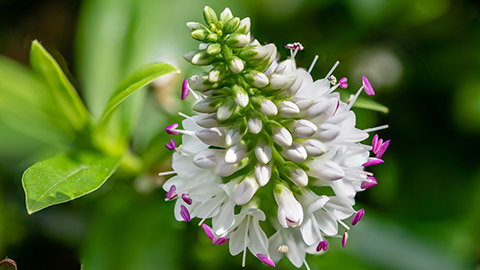
If the flowering structure is more than a single flower it is known as an inflorescence: a grouping of small flowers that seems like a larger flower.
Inflorescences can be divided into:
- Racemose inflorescence: Flowers are borne on a central axis, with the oldest flowers at the base and the youngest at the top. The axis (stem) continues to grow and produce new flowers, so the inflorescence can become quite long and branched. Because it keeps growing, it is also sometimes called an indeterminate or indefinite inflorescence. Examples of plants with racemose inflorescences include the snapdragon and the lily of the valley.
- Cymose inflorescence: Flowers are arranged in a determinate pattern, with the oldest flowers at the top and the youngest at the base. The axis terminates in a flower, so the inflorescence is usually shorter and more compact than a racemose inflorescence. Because the growing point is used up in the formation of a flower, it is also called a definite or determinate inflorescence. Examples of plants with cymose inflorescences include the forget-me-not and the buttercup.
![[ADD IMAGE'S ALT TEXT]](/sites/default/files/SimpleInflorescence.png)
Other descriptive flower features
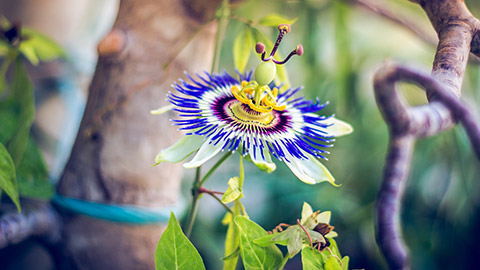
Sometimes it can be useful to give a description of the petals and sepals, in terms of their number, shape, size and colour. Petals are the colorful, leaf-like structures that surround the reproductive parts of the flower. Collectively they are called the carolla, e.g., "a carolla with 10 petals".
- Sepals are the small, green structures that protect the developing flower bud, and these are collectively known as the calyx.
- Stamens are the male reproductive parts of the flower, consisting of the filament and anther. The number, size, shape, and arrangement of the stamens can be important for identifying the flower.
- Pistils are the female reproductive part of the flower, consisting of the stigma, style, and ovary. The size, shape, and arrangement of these structures can be used for identification purposes.
- Bracts are modified leaves that are often located at the base of a flower or on its stem. They can be useful for identification because they can have distinctive shapes and patterns. Where the sepal is part of the flower, a bract may be some distance away.
A detailed description of a flower might be: "A spike of white to pale purple flowers each with white or purple anthers and light-green calyx".
Identifying characteristics of fruit
Fruit descriptions are usually fairly straightforward to interpret and will generally consist of notes about their shape, size, colour, markings, and texture. Remember that a fruit is the part of the plant that contains the seed – it may or may not be edible. For instance, "A 1-2cm bright red, round or oval shaped fruit with dried, brown sepals".
Identifying characteristics of trunks or stems
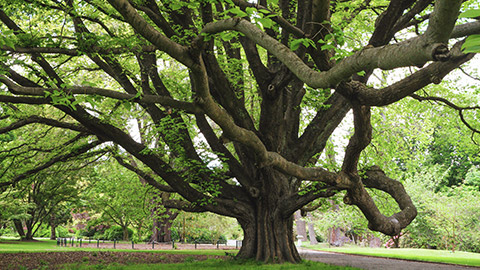
The most common identifying features of trunks are the bark and the shape of the trunk near to ground level. For stems it is the cross-sectional shape and the presence of any fine hairs.
Bark
Bark can be described in terms of its texture, colour and pattern. For example, "Peeling strips of light and dark grey on an otherwise smooth trunk."
Some other descriptions of texture include:
- Smooth
- Lenticels – raised pores in the stem of a woody plant that allows gas exchange between the atmosphere and the internal tissues
- Vertical cracks
- Scales
- Plates
- Vertical strips
- Uninterrupted ridges
- Ridges broken horizontally (The Language of Bark is an interesting read.)
![[ADD IMAGE'S ALT TEXT]](/sites/default/files/European_birch_bark.jpg)
Trunk or stem shape
The shape of a stem is usually round, but in some cases, as with many species of plant from the Lamiaceae (mint) family, they may be square.
We also describe the shape of a trunk – particularly the section from ground level to a few metres up – if it changes significantly. If it does, we refer to this as the buttress. The buttress is a type of structural support that helps the tree to remain stable and upright.
We can describe the buttress as:
- Conical, where it is cone-shaped
- Flared, where it is wider at the base and tapers as it extends up the trunk, giving the tree a more dramatic, flared appearance
- Plank-like, where each buttress is thin, much like a plank of wood.
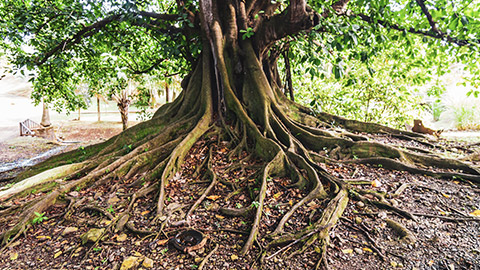
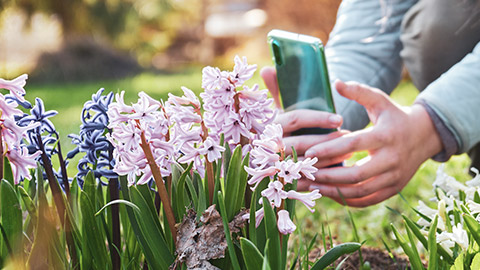
In this subtopic we look at the mobile apps, website databases and other online search strategies that may help you identify plants you see around you. This will become particularly helpful when it comes time to do your Plant Suitability Report (Assessment 1).
Plant identification apps
If you're out and about and want to identify a plant, reach for your phone. The following apps may prove useful:
- NZ Trees - A database of around 230 New Zealand native trees with a simple key of plant features you can use to narrow down the name of the plant you're looking at. NZ Trees was created by AUT and is a free download that doesn't require you to create an account.
- iNaturalist - This is an extremely popular app that links to the iNaturalist website, which was created by the California Academy of Sciences and National Geographic. You need to create an account, but it's free to do so. Once you've created your account, you can use the app or website to upload photos for identification. The database scans your photos and suggests possible family, genus or species. This is a useful starting point. You can either post your observation for others to comment on and contribute their own thoughts about what type of plant it is, alternatively, don't upload it but go ahead and use some other search tools to see if the suggestion it gave seems right.
Plant identification websites
Some of the most useful plant identification websites for plants in Aotearoa are:
- iNaturalist – as mentioned above.
- New Zealand Plant Conservation Network (NZPCN) – Can be searched using the following simple terms:
- Category – Vascular, Non-vascular, Fungi, or Lichen
- Structural Class – such as Trees and Shrubs – Monocotyledons, Orchids, Grasses, Ferns, etc.
- Conservation Status
- Flower Colour
- Native or Exotic.
- Manaaki Whenua Landcare Research’s Flowering Genera of New Zealand interactive key. This can help you narrow your search — by determining the genus (these are grouped by family, so click the + icon to expand it). From there you can use other tools to help work out the species. Turn on feature thumbnails and entity thumbnails. Read the How should you use the key? section on the page: About the key to flowering plant genera for guidance on how best to use the key.
- Shoot Gardening and Wikipedia – as mentioned in Module 1 – are good alternative sources of information, useful for confirming what you've found using the tools above.
To use the Flowering Genera of New Zealand interactive key, enter information you have about the plant into the window in the top left quadrant of the screen. In most cases you'll need to click the + icon next to the text to drop down the options for you to choose from.
As you add more features, the other three quadrants will update. Eventually you will have a shortlist of plants in the top right quarter. In the image below, you can see that we used three features (see the bottom left quadrant) which were: plant form = tree, leaf length = 1000mm and leaf width = 50mm. This narrowed down the possible options from 1284 to nine.
![[ADD IMAGE'S ALT TEXT]](/sites/default/files/Flowering%20Genera%20key.png)
The Department of Conservation recommends using iNaturalist for plant or animal identification, though they note that if it might be a pest or disease, to report it to the Ministry of Primary Industries emergency hotline: 0800 80 99 66 (Department of Conservation ).
Browser searches
If none of these tools are helping, you could try a browser search engine, such as Google. Type in a description of the plant using the terms we mentioned above and see what results you get. A few useful tips when using search engine results:
- Look at the search results for images, specifically. In Google, for instance, on the search results page you can click "Images" at the top of the page to search for images rather than text. You will then be shown thumbnails of your results. If you click on the image, it will appear in a panel on the same page. You can then select the 'Visit' button, which will take you to the image on the webpage it was found on. This allows you to check the context of the image. Sometimes photos are mislabeled, or the author of the webpage has included an alternative species as a point of comparison, which may show up in your search.
- To limit the search results to Aotearoa website pages, you can type site:.nz which will return only webpages that have .nz in the web address.
- If you want to exclude search results based on a term put a - in front of it, e.g., plant with square stem -lamiaceae -mint
- Put quote marks around any words that must be included, and the same applies for words that must be used together, such as "sugar maple" which only return search results where both words are used together in that order.
- It is also useful to ask Google to search the Internet for instances of a specific image. Click the camera icon then upload your photo and it will find images that look similar.
